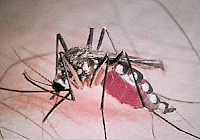The public health side of climate change hasn't exactly been under the radar, but some elements of the impact of a changing climate have. Heat hasn't been overlooked, for example; but you've likely heard less about a rise in insect populations, such as ticks.
Cornell University professor of natural resources and extension wildlife specialist Paul Curtis studies human-wildlife contact and the potential for disease transmission. Curtis believes 2012 will have increased risk for tick borne disease like Lyme disease. “In areas with abundant oaks and mice, it appears tick numbers will be very high based on data collected at the Cary Institute of Ecosystem Studies. While the current mild winter weather does not cause a rise in tick populations, it can change tick behavior. Adult ticks, which are slightly larger than a sesame seed, are normally dormant in winter. Ticks start to seek a host for a blood meal whenever temperatures rise well above freezing. The warm winter of 2011-12 induced earlier than normal tick activity.”
Cornell University professor of natural resources and extension wildlife specialist Paul Curtis studies human-wildlife contact and the potential for disease transmission. Curtis believes 2012 will have increased risk for tick borne disease like Lyme disease. “In areas with abundant oaks and mice, it appears tick numbers will be very high based on data collected at the Cary Institute of Ecosystem Studies. While the current mild winter weather does not cause a rise in tick populations, it can change tick behavior. Adult ticks, which are slightly larger than a sesame seed, are normally dormant in winter. Ticks start to seek a host for a blood meal whenever temperatures rise well above freezing. The warm winter of 2011-12 induced earlier than normal tick activity.”
 |
Relative sizes of several ticks at different life stages. In general, adult ticks are approximately the size of a sesame seed and nymphal ticks are approximately the size of a poppy seed.
Source: CDC |
For those of you interested, a good source of information on preventing Lyme disease is the CDC. Their site has information on preventing tick bites, removing ticks and other topics like signs and symptoms of the disease.
Another disease carrying insect that is coming on strong and showing up earlier than normal this year is the mosquito. Parents are asking local government officials, “….my children are under mosquito nets. I want to know what are you going to do today?” CDC has quite a lot of information on the diseases spread by mosquitoes including West Nile Virus and several varities of encephalitis.
 |
| The treehole mosquito (Aedes triseriatus) transmits the virus that causes La Crosse encephalitis. Source CDC. |
This year’s early interest in Lyme disease, mosquitoes and allergy points to one of the interesting things about human health and climate—the number and types of indirect ways that changing climate patterns can potentially affect health.
Weather and climate patterns that have been constant on the human time scale now appear to show steady and relatively rapid alterations. Although it’s easy to recognize the direct affects from those changes, such as direct heat illness or even death from heat waves or potential drowning from flooding following major storms, the indirect health effects are more numerous and generally less obvious. In our book I introduced many of the indirect health effects that occur in the areas of air quality, water or food borne illness, insect or animal-vector disease, mental health and aggravation of underlying chronic illnesses. For example:
- Air quality - higher temperatures increase air conditioner use and the related increase in fossil fuels to meet electricity demand generates more particulate matter—when you add in the increase in low-level ozone during heat waves—there is the potential for new cases of lung injury and we are likely to see persons with existing respiratory disease (asthma or COPD) have problems.
- Water and food borne illness – extreme weather, both flooding and drought, can affect water and food supplies. While floods can carry biological and chemical contamination to drinking water supplies, droughts can reduce availability of water supplies and also cause higher concentrations of potentially harmful chemicals as water evaporates.
- Insect and animal vectors of disease – Temperature is only one climatic factor affecting the complex life-cycle and population ranges of disease vectors. However, as warmer winters and extended Spring through Autumn breeding seasons allow for increased vector populations across larger geographic area there is further opportunity for disease spread. Geographical ranges for ticks that can carry Lyme disease or Rocky Mountain Spotted fever and for the mosquito species that carry malaria, dengue and West Nile virus have already grown.
- Mental health – Extreme weather and associated anxiety and stress from displacement, job loss and inability to access food and water can cause depression, sleep disorders, drug and alcohol abuse.
- Chronic illnesses – Chronic illnesses of the heart, respiratory tract and other body systems can be aggravated by the effects of heat waves, flooding, drought, forced displacement from home, shortages of suitable food and water supplies and disruption in clinical care access .







+(2)+%5BRead-Only%5D.jpg)

